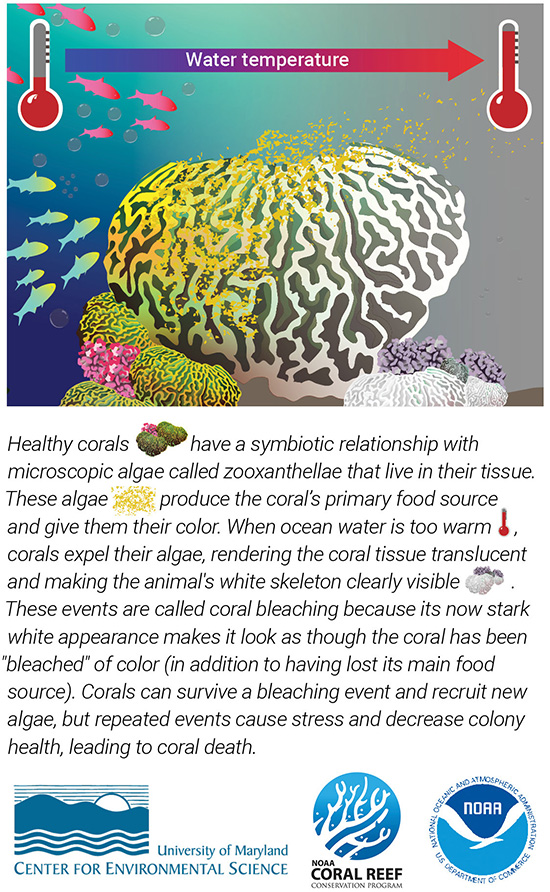- ABOUT US
- PROGRAM AREAS
- CONSERVATION APPROACH
- EDUCATION
- MULTIMEDIA
The Effect of Increasing Water Temperature on Zooxanthellae and Coral Bleaching
This infographic describes the effect of increasing water temperature on the microscopic algae called zooxanthellae that live in coral tissue.
This infographic was made in collaboration with the University of Maryland Center for Environmental Science Integration and Application Network.
Visit the National Coral Reef Monitoring Program's page for all U.S. coral reef status reports.

Infographic Transcript: The Effect of Increasing Water Temperature on Zooxanthellae and Coral Bleaching
Healthy corals have a symbiotic relationship with microscopic algae called zooxanthellae that live in their tissue. These algae produce the coral's primary food source and give them their color. When ocean water is too warm, corals expel their algae, rendering the coral tissue translucent and making the animal's white skeleton clearly visible. These events are called coral bleaching because its now stark white appearance makes it look as the coral has been “bleached” of color (in addition to having lost its main food source). Corals can survive a bleaching event and recruit new algae, but repeated events cause stress and decrease colony healthy, leading to coral death.
About Us

The NOAA Coral Reef Conservation Program was established in 2000 by the Coral Reef Conservation Act. Headquartered in Silver Spring, Maryland, the program is part of NOAA's Office for Coastal Management.

The Coral Reef Information System (CoRIS) is the program's information portal that provides access to NOAA coral reef data and products.
Work With US
U.S. Coral Reef Task Force
Funding Opportunities
Employment
Fellowship Program
Contracting Assistance
Graphic Identifier
Featured Stories Archive

Access the archive of featured stories here...
Feedback
Thank you for visiting NOAA’s Coral Reef Conservation Program online. Please take our website satisfaction survey. We welcome your ideas, comments, and feedback. Questions? Email coralreef@noaa.gov.
Stay Connected
Contact Us
NOAA’s Coral Reef Conservation Program
SSMC4, 10th Floor
1305 East West Highway
Silver Spring, MD 20910
coralreef@noaa.gov
